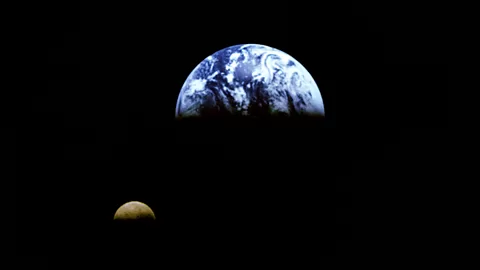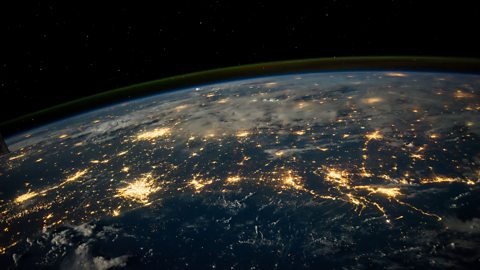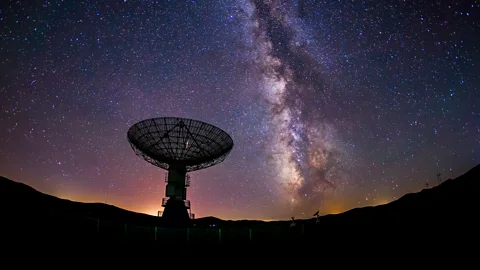Why aliens might already know that humans exist
 Nasa/JSC
Nasa/JSCAlien astronomers might be looking in our direction from distant planets. What would they see?
We've been searching the heavens for some time now. But despite decades of listening for tell-tale radio signals and hunting for signs that other worlds might be even vaguely habitable, it's been slim pickings so far. While astronomers have identified a few possible candidates for where life might conceivably exist elsewhere in the Universe, along with the odd mysterious signal, there is yet to be any concrete evidence of alien life out there.
This article is part of a week of special coverage about extraterrestrial life – all to mark the upcoming 60th Anniversary of the BBC's most famous alien lifeform, Doctor Who.
But what if there was? And what if they were looking back, trying to find us? Would they know there is life on Earth?
That's a question scientists have had to grapple with in recent years, as we continue to inadvertently broadcast our presence out into the galaxy. "Hold the mirror up to yourself in space, and what would they see of us?" says Jacqueline Faherty, an astrophysicist at the American Museum of Natural History in the US. "We're looking. That means other worlds might be looking too."
To date, we have found more than 5,500 planets orbiting other stars in our galaxy, called exoplanets. But such observations are in their infancy – trillions of worlds are likely scattered throughout the Milky Way. Upon some of these worlds we have started to hunt both for the chemical signatures in their atmospheres that might indicate biological activity and even technosignatures that might be emitted by intelligent life forms – radio signals either purposefully or accidentally sent in our direction.
Earth has been unabashedly broadcasting its own presence into the galaxy for about a century now. The most notable period was from 1900 up to World War Two, says Howard Isaacson, an astronomer at the University of California, Berkeley in the US, when our radio transmissions were stronger. "They needed to be more powerful because the radios that people listened to didn't have as sensitive receivers," he says.
We continue to broadcast radio signals today, from TV shows to satellite communications, but in a less detectable way. "Radio stations don't want to broadcast into space," says Thomas Beatty, an astronomer at the University of Wisconsin in the US. "They want to broadcast to the ground." Other more modern forms of communication, like mobile phone signals, are unlikely to be detectable.
 Nasa/JSC
Nasa/JSCBut not all of our signals are so faint. Across the Solar System we have multiple spacecraft exploring different locales such as Mars, Jupiter, and even the outer reaches of the Sun. The furthest of these, Nasa's Voyager 1 spacecraft, is 24 billion kilometres (15 billion miles) from Earth, requiring a powerful network of dishes on Earth known as the Deep Space Network to be communicated with.
In April, Isaacson calculated whether some of these transmissions, up to 20 kilowatts, might reach other stars as they wash over the remote spacecraft and continue their journey into space. He found four nearby stars and any accompanying planets would have already received the transmissions, with more than 1,000 stars likely to hear the signals by the year 2300. "The signal would definitely show up as artificial," says Isaacson. By 2031, the closest of the stars would have had enough time to receive the signals and send their own message back, perhaps an interesting target for future study.
But what if alien astronomers were more dedicated? They might try and observe our planet before receiving any such signals. If they can see our planet pass in front of our Sun, known as a transit, they could see sunlight passing through our atmosphere and pick out its different gases.
In 2021, Faherty found there were nearly 2,000 stars within 300 light-years of Earth that could potentially be able to see such a transit. "It's a good haul of worlds," she says.
The best indicator of life on Earth from such observations might be oxygen, nitrogen, and water vapour, says Paul Rimmer, an astrochemist at the University of Cambridge in the UK, which would "be an indication of a stable liquid ocean".
You might also like:
Nitrogen dioxide could also provide some clues that our planet was inhabited by an intelligent lifeform. The gas is "basically a byproduct of combustion", says Hector Socas-Navarro, an astrophysicist at the Institute of Astrophysics of the Canary Islands in Spain. "So they might deduce we are burning stuff here."
Chlorofluorocarbons from aerosols, refrigerants and other sources could also be a give-away sign of industrial activity on our planet. "We're pretty sure they can only be produced by technology," says Macy Huston, an astronomer at the University of California, Berkeley in the US. (Read more about how we might also be able to spot alien life from their pollution.)
One of the most revealing technosignatures from Earth might not be our atmospheric pollutants or radio signals at all, however, but our city lights. In 2021, Beatty calculated that the sodium emitted from such lights could be detectable in a planet's atmosphere. "It has very sharp spectral features," says Beatty. "You'd never get that through a natural process."
Earth in its current form is likely not urbanised enough to be detectable in such a way, at least within the parameters of our own telescopes. Less than 1% of the Earth's surface is covered by cities. It's a long way from being an ecumenopolis – a planet-wide city, similar to the fictional world of Coruscant in the Star Wars films. If development continues at its current pace, however, by 2150 urbanisation might have swelled by 10 times its current levels, and we might then shine like a beacon to modern telescopes, says Beatty.
But alien civilisations with more advanced telescopes might already be able to spot us. "It's totally feasible that there's alien astronomers that have built a 100m (330ft) space telescope that could be seeing us right now," he says.
Even if alien astronomers had a smaller telescope that could only see the faint dot of our planet, they might still be able to work out it is inhabited. Knowing the tilt and rotation of Earth, the light emitted by our planet could be used to make a crude map of our surface, showing land, oceans, and even coastlines, according to Jonathan Jiang, an astrophysicist from Nasa's Jet Propulsion Laboratory in the US. "As long as you can see a point of light, you can analyse it," says Jiang, who used a spacecraft in our Solar System in 2018 to demonstrate the technique on Earth.
All of this raises the question of whether we really want to be so noticeable. "In movies we always get invaded," says Beatty.
In reality, scientists are more eager to make our presence known, occasionally even sending out purposeful messages into the Universe – such as a famous high-powered radio signal containing a simple pictorial on humanity sent by the now-defunct Arecibo radio telescope in Puerto Rico in 1974. "I'm not really worried about Independence Day scenarios," says Beth Biller, an astronomer at the University of Edinburgh in the UK.
 Getty Images
Getty ImagesAs humanity continues to alter our planet, presuming we don't end our own existence first through war or other means, Earth is likely to become more and more noticeable. Socas-Navarro says that alien astronomers could even one day spot the cloud of satellites orbiting our planet. We would need to have "a billion times what we have now, which sounds like a lot," he says. "But we went from one car to over a billion cars in a few decades."
Perhaps, if we are eager to make first contact, we could do more to make ourselves noticed, such as broadcasts like the Arecibo message. So far, there have only been a handful of further attempts. "If it were just up to me, I'd be broadcasting our existence and hoping someone would answer," says Rimmer. "But that's just my opinion. This is a decision that I think should be made globally."
If the public were in favour, one idea could be to build huge structures in space, says Beatty, such as a large planet-sized triangle or square made of a thin material that would be obviously artificial to alien astronomers. "That would be the main way to get noticed, if we wanted to," he says.
For the time being, signs of our existence are more modest, but still detectable. "They don't need miracles," says Seth Shostak, senior astronomer at the Seti Institute (Search for Extraterrestrial Intelligence) in the US. "They just need the technology we have, but on a larger scale."
The real question we should ask: is anyone looking our way to notice?
--
If you liked this story, sign up for The Essential List newsletter – a handpicked selection of features, videos and can't-miss news delivered to your inbox every Friday.
